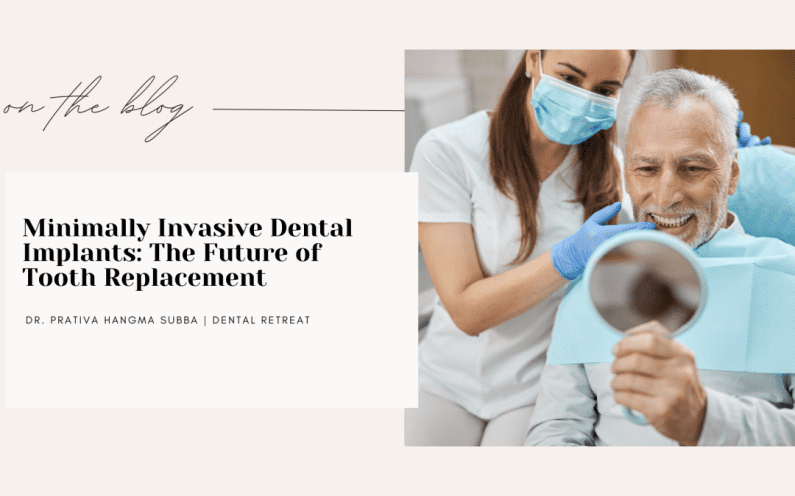Introduction
Minimally Invasive Dental Implants are redefining tooth replacement by reducing pain, recovery time, and surgical complexity while maintaining long-lasting and natural results. This cutting-edge approach leverages advanced techniques and technologies to minimize trauma to the surrounding tissues, offering patients a more comfortable experience and quicker recovery.
In this comprehensive guide, we will explore the science, benefits, techniques, and future trends of Minimally Invasive Dental Implants. Additionally, we’ll connect these advancements to other Minimally Invasive Dentistry solutions like Laser Dentistry for Pain-Free Procedures, Digital Smile Design, and Air Abrasion Dentistry for comprehensive care.
What Are Minimally Invasive Dental Implants?
Minimally Invasive Dental Implants refer to procedures that replace missing teeth using smaller incisions, fewer surgeries, and advanced tools, preserving as much of the natural bone and soft tissue as possible. These techniques are often combined with digital planning tools and less invasive surgical methods to enhance precision and patient outcomes.
The Process of Minimally Invasive Dental Implants
1. Digital Treatment Planning
Digital imaging and 3D cone beam CT scans are used to create a virtual model of the patient’s oral anatomy. This allows precise placement of the implant in the optimal position.
2. Guided Implant Surgery
Using computer-generated surgical guides, implants are placed with high accuracy, reducing the risk of complications.
3. Flapless Surgery
Instead of creating large incisions, flapless surgery involves small, pinpoint holes for implant placement, preserving gum tissue.
4. Immediate Loading
Minimally invasive techniques often allow for same-day placement of the implant and temporary crown, reducing treatment time.
5. Post-Operative Monitoring
Follow-ups with digital tools ensure proper healing and integration of the implant.
Techniques in Minimally Invasive Implant Placement
1. Flapless Surgery
This technique avoids lifting the gum tissue, reducing pain and swelling and promoting faster healing.
2. Piezoelectric Surgery
Uses ultrasonic vibrations to cut bone precisely, minimizing damage to surrounding tissues and nerves.
3. Mini Dental Implants
Smaller implants used in cases with limited bone density, avoiding the need for bone grafting.
4. Ridge Preservation
Bone grafts are placed immediately after tooth extraction to maintain the bone structure for future implant placement.
5. Laser-Assisted Implant Surgery
Incorporates Laser Dentistry for Pain-Free Procedures to ensure precise cuts and reduced inflammation.
Benefits of Minimally Invasive Dental Implants
- Reduced Discomfort:
- Smaller incisions mean less post-operative pain and swelling.
- Quicker Recovery:
- Healing times are significantly reduced due to minimal trauma to soft and hard tissues.
- Fewer Complications:
- Precision techniques lower the risk of infection and implant failure.
- Improved Aesthetics:
- Preservation of gum and bone ensures a more natural-looking restoration.
- Time Efficiency:
- Techniques like immediate loading allow for faster completion of treatment.
- Better Patient Experience:
- Shorter chair time and less invasive procedures enhance patient satisfaction.
Who Are Ideal Candidates for Minimally Invasive Implants?
- Patients with Single Missing Teeth:
Minimally invasive implants provide a natural and durable replacement. - Those with Good Oral Health:
Patients with sufficient bone density and healthy gums are ideal candidates. - Geriatric Patients:
Elderly individuals benefit from the reduced surgical complexity and faster recovery. - Individuals Seeking Aesthetic Solutions:
The natural-looking results of these implants make them a preferred choice for visible teeth.
Minimally Invasive Implants vs. Traditional Implants
| Feature | Minimally Invasive Implants | Traditional Implants |
|---|---|---|
| Incision Size | Small or no incisions | Larger incisions |
| Healing Time | Faster | Slower |
| Pain and Discomfort | Minimal | Moderate |
| Surgical Complexity | Reduced | Higher |
| Cost | Comparable, sometimes higher | Comparable |
How Minimally Invasive Implants Integrate with Other Techniques
1. Digital Smile Design (DSD) Integration
Minimally invasive implants are often planned as part of Digital Smile Design to ensure they align with the patient’s aesthetic goals.
2. Laser-Assisted Enhancements
Using Laser Dentistry for implant procedures minimizes bleeding and accelerates healing.
3. Air Abrasion for Adjacent Teeth
When adjacent teeth require minimal repairs, Air Abrasion Dentistry can be employed to preserve tooth structure.
4. ICON Resin Infiltration for Adjacent Lesions
For early caries near the implant site, ICON Resin Infiltration offers a non-invasive solution.
Challenges and Limitations
- Cost:
- Advanced technology and expertise can increase costs.
- Limited Bone Support:
- Patients with severe bone loss may still require bone grafting or alternative methods.
- Learning Curve for Practitioners:
- Dentists need extensive training to master minimally invasive techniques.
- Not Suitable for All Cases:
- Complex cases may still require traditional surgical methods.
Also read our blog on Preventive Sealants: Shielding Smiles from Cavities
Future Trends in Minimally Invasive Dental Implants
- AI-Guided Surgery:
- Artificial intelligence is enhancing precision in treatment planning and execution.
- Biomimetic Materials:
- The development of materials that mimic natural bone will further improve implant integration.
- 3D Printing:
- Customized implant guides and restorations will become even more accessible.
- Regenerative Techniques:
- Innovations in tissue engineering may eliminate the need for bone grafts altogether.
Also read our blog on Ultra-Thin Veneers: Transforming Smiles with Minimal Intervention
Why Choose Minimally Invasive Dental Implants?
Minimally Invasive Dental Implants provide a patient-centered solution that prioritizes comfort, efficiency, and aesthetics. By integrating these procedures with advanced techniques like Laser Dentistry and Digital Smile Design, patients can achieve comprehensive oral health and an enhanced smile.
Conclusion
Minimally Invasive Dental Implants are revolutionizing restorative dentistry by combining advanced technology with a focus on patient comfort and outcomes. Whether you’re missing one tooth or several, these techniques offer a reliable, aesthetic, and efficient solution for tooth replacement.
To learn more about advanced dental procedures, visit our Blog Page on Minimally Invasive Dentistry and explore related treatments like ICON Resin Infiltration and Silver Diamine Fluoride (SDF).
